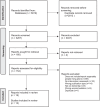Non-Pharmacological Interventions for People With Dementia Who Live Alone: A Systematic Review
- PMID: 40011198
- PMCID: PMC11864918
- DOI: 10.1002/gps.70059
Non-Pharmacological Interventions for People With Dementia Who Live Alone: A Systematic Review
Abstract
Objectives: Approximately one third of people with dementia live on their own and they face an increased risk of unmet needs and loneliness. This systematic review aimed to identify and describe non-pharmacological interventions that have been evaluated for people with dementia living alone and to examine the effectiveness of these interventions.
Methods: Following PRISMA guidelines, six databases were systematically searched: MEDLINE, Embase, CINAHL, PsycINFO, Social Care online, and ClinicalTrials.gov. Studies that reported on the impact or experience of an intervention for people with dementia living alone in the community (not long-term care) and that had been published since 2000 were included in the review. No restrictions were applied in terms of study design or outcome measures. Study risk of bias was assessed, and a narrative approach was used to synthesize findings.
Results: Thirteen studies of 13 different interventions were included, grouped into five intervention categories: home-based dementia case/care management (n = 4), technology (n = 3), social (n = 3), cognitive (n = 2) and psychological (n = 1). There was one randomized controlled trial (RCT), and two economic evaluations that used data from RCTs. Most other studies were small-scale, and only two were evaluated to have low risk of bias. Most studies reported positive or mixed findings in terms of the intervention's impact on the person with dementia or aspects of feasibility. However, studies were heterogeneous in terms of intervention, study design, and outcomes.
Conclusions: This review of a limited body of research highlights the potential for interventions to support people with dementia who live alone. It also identifies key evidence gaps and the need for more robust and comparable research to better understand what works, why, for who, and how. Involving people with dementia who live alone in the design, implementation, and evaluation of these interventions will be crucial to ensure that their needs and preferences are met.
Keywords: dementia; interventions; living alone.
© 2025 The Author(s). International Journal of Geriatric Psychiatry published by John Wiley & Sons Ltd.
Conflict of interest statement
The authors declare no conflicts of interest.
Figures



References
-
- Nichols E., Steinmetz J. D., Vollset S. E., et al., “Estimation of the Global Prevalence of Dementia in 2019 and Forecasted Prevalence in 2050: An Analysis for the Global Burden of Disease Study 2019,” Lancet Public Health 7, no. 2 (2022): e105–e125, 10.1016/s2468-2667(21)00249-8. - DOI - PMC - PubMed
Publication types
MeSH terms
Grants and funding
LinkOut - more resources
Full Text Sources
Medical
Miscellaneous

